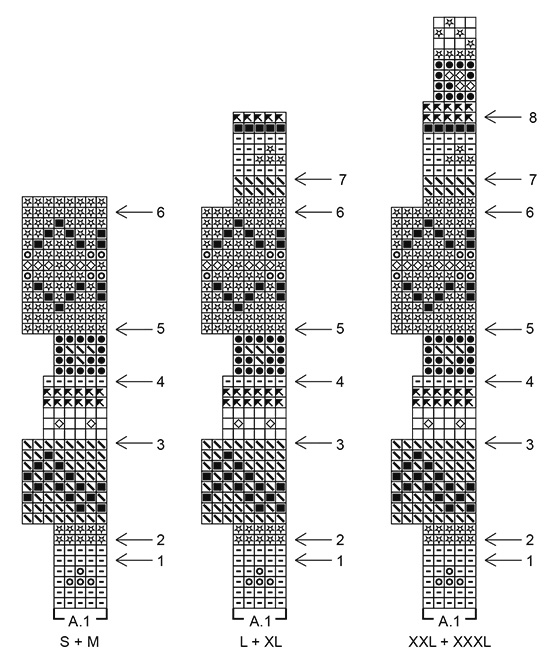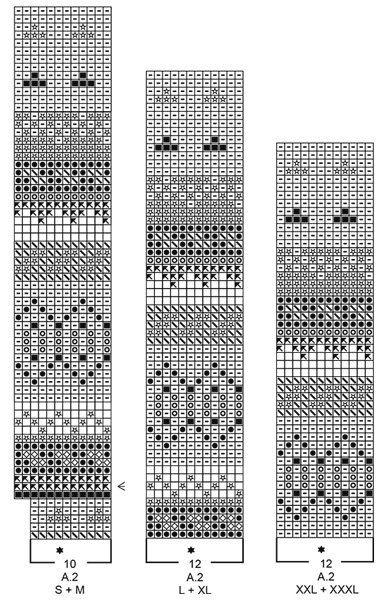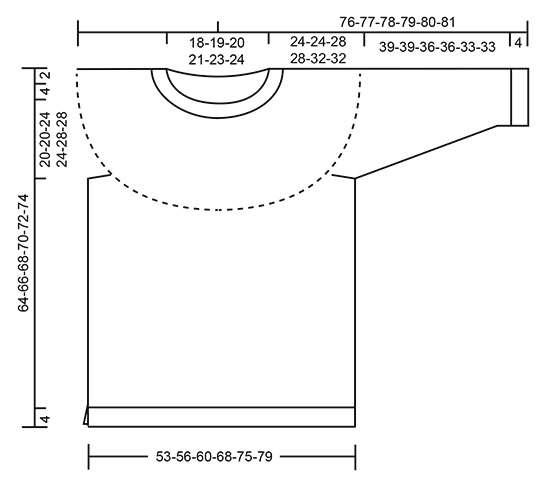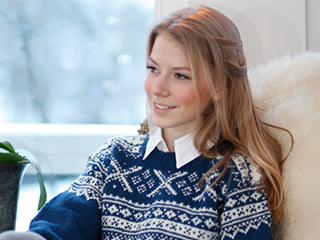Magic Mountain |
||||||||||||||||||||||||||||||||||
 |
 |
|||||||||||||||||||||||||||||||||
Knitted jumper with round yoke and multi-coloured Norwegian pattern, worked top down. Sizes S - XXXL. The piece is worked in DROPS Paris.
DROPS 187-8 |
||||||||||||||||||||||||||||||||||
|
INFORMATION FOR THE PATTERN: RIDGE/GARTER STITCH (worked in the round): 1 ridge = 2 rounds. Knit 1 round and purl 1 round. RIDGE/GARTER STITCH (worked back and forth): 1 ridge = Knit 2 rows DECREASE/INCREASE TIP (evenly spaced): To work out how to decrease/increase evenly, count the total number of stitches on the needle (e.g. 90 stitches) and divide by the number of decreases/increases to be made (e.g. 6) = 15. In this example, decrease by knitting together every 14th and 15th stitch. When increasing make 1 yarn over after every 15th stitch. On the next round/row work the yarn overs twisted to avoid holes. PATTERN: See diagrams A.1 and A.2. Choose diagram for your size. The whole pattern is worked in stocking stitch. KNITTING TIP: To avoid the knitting tension becoming tighter when working pattern, it is important that the strands at the back of the piece are not tight. You can use a size larger needle when working pattern if this is a problem. DECREASE TIP (for mid under sleeve): Start 2 stitches before the marker thread, knit 2 together, slip 1 stitch as if to knit, knit 1, pass the slipped stitch over the knitted stitch (= 2 stitches decreased). ---------------------------------------------------------- JUMPER: The yoke and body are worked in the round with circular needle, top down to where the rib begins, then the front and back pieces are worked separately back and forth. The sleeves are worked in the round with short circular needle/double pointed needles, top down. NECKLINE: Cast on 90-96-96-102-102-108 stitches with short circular needle size 4.5 mm and raspberry. Knit 1 round. Change to dark beige and work the next round as follows: * Knit 3, 3 stitches in GARTER STITCH – see description above *, work from *-* to end of round. Continue the rib like this until the neck measures 4 cm. Knit 1 round where you decrease 6-10-6-8-4-6 stitches evenly on round – read DECREASE/INCREASE TIP = 84-86-90-94-98-102 stitches. Change to circular needle size 5.5 mm. Knit 1 round where you increase 31-29-30-31-32-33 stitches evenly on round = 115-115-120-125-130-135 stitches. Then work the yoke as described below. YOKE: Work A.1 in the round (= 23-23-24-25-26-27 repeats of 5 stitches). Continue the pattern as shown in the diagram. Read KNITTING TIP and REMEMBER THE KNITTING TENSION! AT THE SAME TIME on each round marked with an arrow in the diagram increase as described below: Arrow-1: Increase 15-19-20-22-23-25 stitches evenly on round = 130-134-140-147-153-160 stitches. Arrow-2: Increase 14-18-20-21-23-24 stitches evenly on round = 144-152-160-168-176-184 stitches (you now have room for 18-19-20-21-22-23 repeats of 8 stitches). Arrow-3: Increase 30-34-38-42-40-44 stitches evenly on round = 174-186-198-210-216-228 stitches. Arrow-4: Increase 26-29-32-35-34-32 stitches evenly on round = 200-215-230-245-250-260 stitches (you now have room for 40-43-46-49-50-52 repeats of 5 stitches). Arrow-5: Increase 24-25-26-27-30-28 stitches evenly on round = 224-240-256-272-280-288 stitches (you now have room for 28-30-32-34-35-36 repeats of 8 stitches). Arrow-6: Increase 18-20-12-20-24-24 stitches evenly on round = 242-260-268-292-304-312 stitches. The increases are finished in sizes S and M. L + XL + XXL + XXXL: Arrow-7: Increase 12-18-21-18 stitches evenly on round = 280-310-325-330 stitches. Increases are finished in sizes L and XL. XXL + XXXL: Arrow-8: Increase 19-18 stitches evenly on round = 344-348 stitches. Increases are finished in sizes XXL and XXXL. ALL SIZES: = 242-260-280-310-344-348 stitches. Finish working A.1. The piece measures approx. 24-24-28-28-32-32 cm from the cast-on edge. The next round is worked as follows (with moss green in sizes S and M, apricot in sizes L and XL and with off white in sizes XXL and XXXL): Place the first 42-46-52-55-60-60 stitches on 1 thread for sleeve, cast on 6-6-8-8-8-12 new stitches on the needle (= in side under sleeve), knit 79-84-88-100-112-114 stitches (= front piece), place the next 42-46-52-55-60-60 stitches on 1 thread for sleeve, cast on 6-6-8-8-8-12 new stitches on needle (= in side under sleeve) and knit the remaining 79-84-88-100-112-114 stitches (= back piece). Cut the strands. Body and sleeves are finished separately. THE PIECE IS NOW MEASURED FROM HERE! BODY: = 170-180-192-216-240-252 stitches. Insert 1 marker thread in the one side of the piece, in the middle of the 6-6-8-8-8-12 stitches cast on under sleeve. Start the round here and work A.2 in the round (= 17-18-16-18-20-21 repeats of 10-10-12-12-12-12 stitches). On the round marked with arrow-7 in A.2 decrease 2 stitches evenly on round (applies only to size S) = 168-180-192-216-240-252 stitches. When A.2 has been completed, the piece measures approx. 33-33-29-29-25-25 cm from the division. Continue with stocking stitch and dark beige. When the piece measures 34-36-34-36-34-36 cm from the division (or to desired length, there is 4 cm left to finished length) divide the piece for a split in each side. Keep the first 84-90-96-108-120-126 stitches on the needle and place the remaining 84-90-96-108-120-126 on 1 thread or extra needle. Knit 1 row from the right side - AT THE SAME TIME increase 15-21-21-21-21-27 stitches evenly on this row (do not increase over the outermost 3 stitches in each side) = 99-111-117-129-141-153 stitches. Change to circular needle size 4.5 mm and work rib as follows from the wrong side: 3 edge stitches in GARTER STITCH – see description above, * purl 3, knit 3 *, work from *-* until there are 6 stitches left on the row, purl 3 and finish with 3 edge stitches in garter stitch. Continue the rib like this for 4 cm. Cast off with garter stitch over garter stitch, knit over knit and purl over purl, but to avoid the cast-off edge being tight, make 1 yarn over after every 6th stitch at the same time as you cast off (yarn overs cast off as normal stitches). Work in the same way over the stitches on the thread/extra needle. The jumper measures approx. 64-66-68-70-72-74 cm from the shoulder down. SLEEVE: Place the 42-46-52-55-60-60 stitches from the thread on the one side of the piece on short circular needle size 5.5 mm and, in addition, knit up 1 stitch in each of the 6-6-8-8-8-12 stitches cast on under the sleeve = 48-52-60-63-68-72 stitches. Work the first round in A.2 and decrease at the same time 1-1-1-0-1-1 stitch on this round = 47-51-59-63-67-71 stitches. Insert 1 marker thread at the beginning of the round (= mid under sleeve) and 1 marker thread in the middle of the round (= mid top of sleeve). Work A.2 in the round, but start the round as described below: In sizes M, L and XXXL work A.2 from and including stitch 2 in the diagram. In size S work A.2 from and including stitch 3 in the diagram. In size XXL work A.2 from and including stitch 4 in the diagram. In size XL work A.2 from and including stitch 6 in the diagram. When starting on these different stitches, all sizes will then match the marker thread on top of sleeve with the stitch marked with a black star in the diagram, but because of different numbers of stitches in A.2 in sizes S and M the start of the round will need to be recounted when the number of stitches in the repeat has changed to 12 stitches in these sizes. AT THE SAME TIME when the piece measures 3-3-3-2-2-2 cm from the division, decrease 2 stitches mid under the sleeve – read DECREASE TIP. Decrease like this every 5½-5-3-3-2½-2 cm a total of 7-8-11-12-13-15 times = 33-35-37-39-41-41 stitches. When A.2 has been completed finish working the sleeve with dark beige. When the piece measures 39-39-36-36-33-33 cm from the division, knit 1 round where you increase 9-7-5-9-7-7 stitches evenly on round = 42-42-42-48-48-48 stitches. Change to double pointed needles size 4.5 mm and work rib in the round (= knit 3 / purl 3). When the rib measures 4 cm cast off with knit over knit and purl over purl, but to avoid the cast-off edge being tight, make 1 yarn over after every 6th stitch at the same time as you cast off (yarn overs cast off as normal stitches). The sleeve measures approx. 43-43-40-40-37-37 cm from the division. Work the other sleeve in the same way. |
||||||||||||||||||||||||||||||||||
Diagram explanations |
||||||||||||||||||||||||||||||||||
|
||||||||||||||||||||||||||||||||||

|
||||||||||||||||||||||||||||||||||

|
||||||||||||||||||||||||||||||||||

|
||||||||||||||||||||||||||||||||||
|
Have you made this or any other of our designs? Tag your pictures in social media with #dropsdesign so we can see them! Do you need help with this pattern?You'll find tutorial videos, a Comments/Questions area and more by visiting the pattern on garnstudio.com. © 1982-2024 DROPS Design A/S. We reserve all rights. This document, including all its sub-sections, has copyrights. Read more about what you can do with our patterns at the bottom of each pattern on our site. |
||||||||||||||||||||||||||||||||||











































































Comments / Questions (71)
I made the small size and the body was too big but the sleeves were really, really tight from the armpit down with a baggy cuff. I had to rework the sleeves using another pattern and undoing all the Nordic pattern.
28.03.2024 - 14:32I found this pattern easy to follow but the tension 16 stitches to 10cm on 5.5 mm needles doesnt tally with the ball band which is 17 sts to 10 cms on 5 mm needles. That 1 stitch difference makes a huge difference to the final garment if not addressed but using larger needles just makes the knitting loose and sloppy .
30.01.2024 - 17:37Beste mensen, Is het de bedoeling om het proeflapje voor de naalden 5,5 te breien met een meerkleurig inbreipatroon of gewoon unikleur tricotsteek? Vriendelijke groet, Diana
16.02.2023 - 15:33DROPS Design answered:
Dag Diana,
Je kunt het proeflapje gewoon in tricotsteek breien, tenzij je van jezelf wet dat je altijd strakker of juist losser breit wanner er zo'n patroon in zit. In dat geval is het beter om ook het proeflapje in tricotsteek te breien.
18.02.2023 - 10:24Hallo, laut Beschreibung habe ich 325 Maschen (für größe L)auf der Nadel, wenn ich mit den Zunahmen der Passe in A1 fertig bin. danach kommt in der Beschreibung: "alle Größen: = 280 Maschen für Größe L. wann oder wo wurden denn die 45 Maschen abgenommen????
02.01.2023 - 16:06DROPS Design answered:
Liebe Frau Siebe, nach dem 6. Pfeil haben Sie 268 Maschen in L, dann nehmen Sie 12 Maschen zu = 268+12=280 Maschen (in diesem Teil ist L die 1. Größe). Viel Spaß beim stricken!
02.01.2023 - 16:34Hi Guys. Love the jumper chosen for neckline. The first pattern I’ve tried of yours. I’m trying to knit the large just a fraction too big really but … Casting 96 sts to knit in the round. Knitted down past the petrol colour. Neck looks too tight. Tried it on and it’s a polar neck. Not at all like the neckline in the photo. I must be doing something wrong as can’t see anyone with this problem. Can you help me please? Thank you. 🧶
04.12.2021 - 16:09DROPS Design answered:
Dear Kathy, you need to check your gauge; if it is too tight you can use a larger needle to cast on and work at the beginning. Happy knitting!
05.12.2021 - 17:09Je souhaiterai faire ce modèle en ALPAGA brushed alpaca silk de même groupe. Cette qualité est en pelote de 25 g. Il me semble que cela fait beaucoup de pelotes et donc très cher. N'y a t'il pas une erreur? Merci
15.09.2021 - 10:40DROPS Design answered:
Bonjour Mme Grasset, utilisez notre convertisseur pour calculer la quantité exacte requise en DROPS Brushed Alpaca Silk pour chaque couleur (ex pour 250 g Paris, il vous faut 75 g Brushed Alpaca Silk, soit 3 pelotes). Rappelez-vous juste bien que le résultat sera différent de celui de la photo si vous utilisez cette alternative. Votre magasin saura vous conseiller si besoin. Bon tricot!
15.09.2021 - 15:47Hoi ik wil graag deze trui breien maar wil graag geen roze kleuren maar wil die blauwe kleuren zou dat ook kunnen. Groetjes Jolanda
26.04.2021 - 22:02DROPS Design answered:
Dag Jolanda,
Jazeker kan dat. Je bent natuurlijk vrij om te kiezen welke kleuren je gebruikt.
29.04.2021 - 14:54Hoi ik wil graag deze trui breien maar wil graag geen roze kleuren maar die blauwe kleuren kan dat ook. Stuur maar door naar
26.04.2021 - 21:55Ich hatte mich auf einen hellen Norweger Pullover gefreut, gerade Recht fürs Frühjahr. Es wurden die originalen Farben bestellt lt ihrerseits Anleitung. Es wird ein dunkler Pullover und hat nichts mit ihrer Abbildung zu tun. Bei der Anleitung wäre die Reihe 9 apricot. Im Originalbild ist ihr Pullover hier grün rot. Die Grundfarbe ist ein dunkelbeige statt der schönen hellen Farbe auf dem Foto. Furchtbar. Umsonst Geld ausgeben.
11.04.2021 - 15:39Ich komme mit dem Muster der Ärmel nicht klar. Bei Größe M habe ich zu Beginn 51 Maschen auf der Nadel. Wenn ich ab der 2. Masche mit dem Muster beginne bin ich am Ende der Reihe nicht mehr im Muster. Die letzte Musterfolge bleibt unvollständig
11.04.2021 - 12:38DROPS Design answered:
Liebe Rosemarie, beginnen Sie mit der leztzen 9 Maschen in A.1, dann wiederholen Sie A.1 4 Mal, dann strickens Sie die 2 ersten M in A.1 = 9+40+2=51Maschen. Viel Spaß beim stricken!
12.04.2021 - 09:43